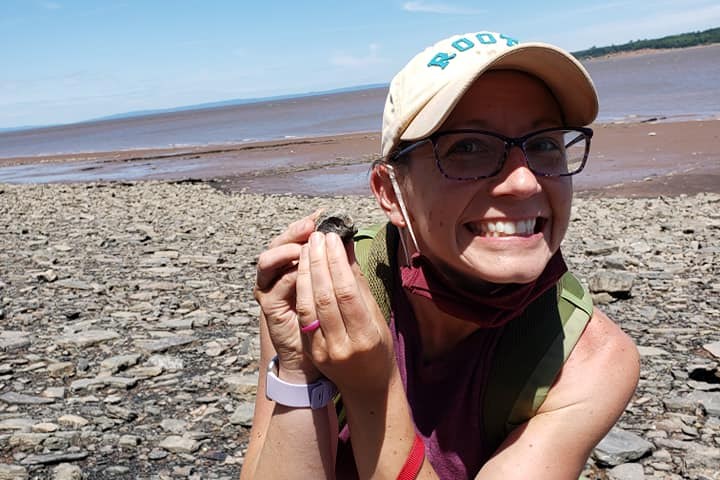A Dalhousie University instructor's rare and significant fossil find

Jennifer Frail-Gauthier says there was excitement in the air as she led a group of students on a fossil hunt at Blue Beach near Hantsport nearly two weeks ago.
"It was the first in-person course that students had had in almost a year and a half," said the Dalhousie University biology instructor.
But none of them could have imagined just how successful the trip would be.
Of the thousands of rocks on the beach, Frail-Gauthier stumbled upon a significant find; a 350 million-year-old fossilized tetrapod skull.
"I looked down and I knew from years of going to Blue Beach and hunting for tetrapod fossils that we wanted to look for something that was black," she told NEWS 95.7's talk show. "Black means bone in the rock."
"So when I looked down on this little tiny rock, I saw this round oval and I thought for sure that was one of the big fish scales of the fish that lived at that place at that time. But when I picked it up, the fossil was completely the same on the other side. There was another indentation with another black oval ... I didn't know what it was, but I knew it was something important."
Frail-Gauthier brought the find to Chris Mansky at the Blue Beach Fossil Museum near the Minas Basin beach.
"He was speechless," she said. "He knew right away what it was because they had found one about five years ago."
Frail-Gauthier explained the discovery is extremely valuable to the evolutionary record as there is a fossil gap for tetrapods in this time period, thought to be when these four-limbed animals with fingers and toes moved from water to land.
"Important fossils from before Blue Beach are around 360 million years old, and they are tetrapods that still lived in the water ... and then the first fossils after that time period are 340 million years old and they are full on amphibian-like tetrapods," she said.
"That's why this fossil is so important, because it could represent that transitional time from the tetrapods living in water, to the tetrapods living on land."
Frail-Gauthier believes she had a one in a million chance of stumbling on this fossil.
"Every day the tide exposes new fossils, but what's crazy is the tide can just take them away the next day," she said.
She calls Nova Scotia one of the most geologically rich places in the world.
"There was intense sedimentation coming down into the Fundy basin 350 million years ago. It was warm, shallow seas, so it was the perfect breeding ground for animals and plants," she explained.
"Joggins is about 40 million years later than Blue Beach, it's about 310 million years ago, but it was all part of the geological time period called the Carboniferous period."
If the fossil find has inspired you to head out and do your own search, you should know that all palaeontology and archaeology sites, including Joggins and Blue Beach, fall under the Special Places Protection Act, so you won't be able to keep your discoveries.
"So it's really important to not just go, find fossils and take them away," said Frail-Gauthier. "They could actually have a lot of significance."
No comments:
Post a Comment